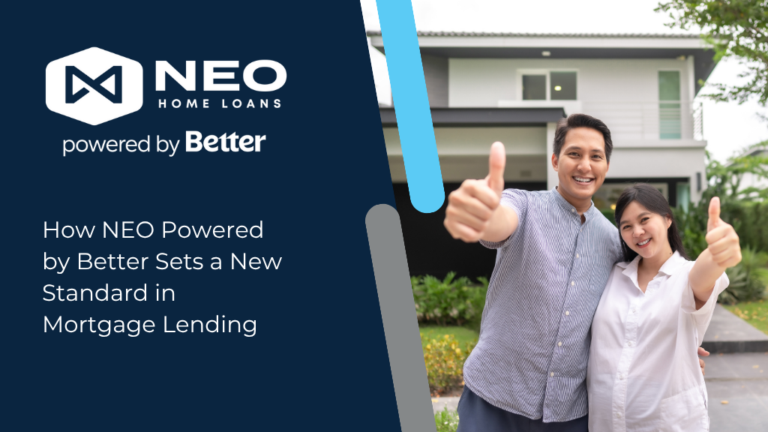
This article was originally posted on moneygeek.com with collaboration from Ryan Grant, Division President at NEO Home Loans.
A home equity line of credit, or HELOC for short, is a loan that uses the equity you’ve gained on your home as collateral. Typically, a HELOC is calculated by subtracting the amount you owe on your mortgage from up to 85% of the appraised value of your home.
While the approved loan amount may still depend on your debt-to-income (DTI) ratio and your credit score, your balance is available whenever you need it, and you only pay interest on the amount you borrow.
However, a HELOC may not be the right choice for everyone, as it can put you at risk of losing your home should you not be able to make payments. Before taking one out, find out how a HELOC works and whether the repayment structure is appropriate for your situation.
What Is a Home Equity Line of Credit (HELOC)?
A HELOC is a revolving line of credit secured by your home’s equity. Lenders will look at your credit score and debt-to-income (DTI) ratio and ensure you have at least 15% equity in your home to qualify. From there, they may approve a maximum amount you can borrow, and you can withdraw any amount under or up to your approved limit using a checkbook or a credit card connected to the account.
HELOCs typically have a draw period, a time frame during which you can borrow from the account. Once this period is up, you will have to renew your credit line or start repaying the amount you borrowed.
HELOCs generally come with a variable interest rate, which means your payments can change over time. A variable rate can work in your favor if it goes down, but if it goes up or you can no longer afford to repay, you face the risk of losing your home.
Your home is collateral for the HELOC, so if you default on payments, the bank can take your home to make up for it. If you decide to sell your home, you will need to pay off your HELOC as part of the process.
How Do HELOCs Work?
If you’re approved for a HELOC, lenders will approve you for a maximum amount that’s based on several factors, including how much equity you have in your home and your credit history. The equity in your home refers to the property’s total value, minus anything you currently owe on mortgages and home equity loans. HELOCs have an application process similar to that of a conventional mortgage, which involves looking at your total financial picture.
The credit on a HELOC revolves. Just like a credit card, as you pay off the principal, your balance is reduced and available credit replenished. Some plans have limitations on how you can use these funds, with minimum withdrawal amounts and outstanding balance caps. Certain lenders require an initial advance when the line is established. Depending on the lender, you may use your HELOC by writing a check, using a debit card that’s tied to the account or simply transferring funds into your checking account.
HELOCs generally involve a variable, rather than fixed, interest rate. The rates must be published on a public index (like a daily newspaper) and will be subject to constant change. Lenders generally offer a margin to the index, and by law, variable-rate plans always have a cap on the interest rates. However, if you have used up your credit line and are having trouble paying it down, you may find the interest rate climbing to an unmanageable level — whether it’s capped or not.
TIP: It is important to look at the annual percentage rate (APR) and the costs of establishing the plan when considering a HELOC. An APR is the annualized interest rate for a whole year, rather than just a monthly fee or rate, as applied on a loan, mortgage loan or credit card. Some lenders may offer you the option to change to a fixed rate during the life of the plan.
Most plans set a fixed amount of time you can borrow money, such as five or 10 years. At the end of the set period (known as the “draw period”), you may be able to apply for a renewal if the plan allows it. When the period closes, some plans may ask for payment in full, while others allow for what is known as a “repayment period.” There are also costs involved in setting up a home equity line of credit, such as an application fee, the cost of an appraisal and closing costs. When considering a HELOC, it is important to calculate these figures into your decision on whether this credit is viable to you.
How Different Are HELOCs from Credit Cards?
HELOCs are different from other forms of credit, such as a mortgage or a credit card. When closing on a HELOC, a draw period is established. Typically, this is five or 10 years. During this time, homeowners withdraw money and only have to make minimum monthly payments — interest on what they withdrew. After the draw period, repayment begins over a period of typically 20 years. During the repayment period, monthly payments cover principal and interest. At the end, the HELOC will be repaid in full.
HELOCs also often require you to take out money as soon as the deal is signed. There is generally an initial withdrawal that’s required (referred to as the draw requirements) and a minimum monthly balance to be kept.
Rates on HELOCs can change, and many lenders will offer a temporary discounted rate known as an “introductory rate.” This rate is usually low for only a short time (for example, six months) before it goes up in accordance with the variable market interest rate. It’s important you consider this a discount, not a set rate.
How Are Interest Rates and Payments Calculated?
A HELOC is written with an adjustable rate that changes with market interest rates. The most common scenario involves the prime interest rate and an interest margin. The prime interest rate is governed by the Federal Reserve and changes several times a year. The margin amount added to your prime rate is based on your credit history and equity amount by the lender. Margin rates can be as low as 2% and as high as 12%.
Once the draw period is over and the repayment period begins, the monthly payment generally includes any amount to pay down on the balance, plus any remaining balance on interest. At this point, loan payments are amortized, and the monthly amount is fixed.
For example:

What Are the Best Uses for a HELOC?
According to Linda Guel, a mortgage loan officer at NorthWest Plus Credit Union, the most common uses of HELOCs are debt consolidation and home renovations.
“With today’s low rate environment, HELOCs can be a smart and flexible way for customers to improve their home, consolidate debt or deal with an unexpected cost, such as a medical bill. A HELOC can help fund major life events such as children’s college expenses, weddings and more,” adds Mike Kinane, senior vice president of home equity at TD Bank.
Common uses of a HELOC include:
Renovation. Major banks report this as the number one reason for applying for a HELOC. Although you are taking equity from your home, you are reinvesting in the property and adding to the value. Renovations range from necessary repairs, such as a new roof or septic system, to upgrading a kitchen and putting on additions.
Education. Not only is the interest rate sometimes lower than a student loan, but the total available amount of a HELOC is higher. Using a HELOC for college provides flexibility but also requires borrowers to put their homes potentially at risk.
Investment. Some savvy homeowners will use a HELOC to invest on a higher return, as long as the interest rates remain low. It can also provide the initial capital for starting a business, but this should be approached with extreme caution. “The equity you own in your home is a valuable asset and, for many homeowners, a missed opportunity if they aren’t leveraging it,” Kinane says. However, unless you’re certain of the return and very experienced in investments, it may not be worth the risk to your home.
Paying off debt. A HELOC can be used to consolidate debt with high interest rates, such as credit card debt, car loans and other debts. However, it’s critical borrowers remember their house is now on the line. “Having a good understanding of your financial situation is a responsible step to take when obtaining any type of credit, whether it’s a credit card, auto loan or HELOC. Determine your unique personal situation and long-term goals when considering a HELOC,” Kinane says.
Choosing a Lender
Convenience can be expensive, and you don’t necessarily have to use the same lender as you did with your mortgage. Just like any type of loan, you need to shop around for the best possible fit. Questions to ask lenders should include costs like closing and application fees. You should also shop around for the index margin and total interest rate you are being offered, as the margin can vary by lender.
There is no set number of lenders with whom you should inquire, but remember, costs are incurred for each application you have processed. You should receive a Truth-in-Lending disclosure from each lender, and cost comparison should include the APR, amount financed, finance charges and additional fees. The amount financed is not the total amount of your equity, but rather the cost minus fees and payments (which is considered by HUD as part of the finance costs and APR calculation).
You can apply for your HELOC through a bank, credit union or non-bank lender, depending on your needs. Banks typically work with borrowers who have a credit score of 750 or higher, whereas credit unions and non-bank lenders tend to be more lenient. Banks also tend to close quicker and offer lower introductory rates, which may balloon over time. The choice of who finances your HELOC is personal and should be based on your needs and which institution is offering you the best rates.
“HELOCs are often advertised as having low costs for opening them up,” says Reiss of Brooklyn Law School. “Those costs are important, but you also want to make sure that the interest rate is competitive because you can save money on the costs and then quickly lose those savings and more on the interest. Does the lender require that you withdraw a certain amount from the HELOC for a certain amount of time, thereby making you accrue interest even if you do not need the money right away? Does the lender charge any type of maintenance fee? Shop around and compare the APRs of the HELOCs you are considering.”
Ultimately, shopping around benefits the consumer. “Consumers shopping for HELOCs should look for a lender who will lock in today’s low rates against all, or a portion, of what they borrow from their credit line,” says Kinane of TD Bank. “HELOCs should provide consumers with financial flexibility, so choose a lender who offers multiple and convenient ways to borrow against or pay down your credit line.”
Applying for a HELOC
Many homeowners are pleased to find the application process for a HELOC is not as strenuous as mortgages. Getting approved for a HELOC is often faster than applying for a mortgage. Your application will include:
- A completed loan application
- A signed Borrower’s Authorization to Release Information form
- Two years’ worth of W-2s or tax returns
- Two years’ worth of Schedule K forms if you’re self-employed
- Bank statements
- Other asset information, such as investment accounts and retirement assets
- All information pertaining to any real estate that you own
- Information on outstanding debts on the property, including your mortgage lender
Once you’ve assembled the information, you can expect the following general timeline:
- Initial application. Start the process by submitting your application and supporting documentation. Homeowners can speed up the process by initially submitting the basics and having everything assembled and ready to go.
- Title search and appraisal. Once your application is received, the bank will request a title search and appraisal to determine ownership and the value of your home.
- Preliminary approval. If a lender approves you for a HELOC, you’ll receive the terms. If you decide to move forward, the lender will verbally confirm that your employment information is the same and your insurance coverage is current.
- Close. The close will be scheduled, often within two weeks of the initial application, pending any delays in the process.
- Funds available. Funds are typically available within days or weeks of the signed lending close.
HELPFUL HELOC APPLICATION TIPS
- “Don’t apply for other credit lines before shopping for a HELOC. Those applications can lower your credit score and increase the cost of the HELOC,” Reiss says. “Check with your accountant or financial advisor to confirm that the interest on the HELOC will be tax deductible. It likely will be, but it is good to confirm this.”
- Understand the difference between “draw period” and “repayment period.” Know when your rates will increase and how this will affect your payment.
- Understand your credit score and how that’s likely to determine rates. Decide if you should take steps to improve your credit score before applying.
- Carefully review your Truth-in-Lending disclosure.
- Look out for any minimum draw or maximum balance requirements.
- Avoid a HELOC that calls for a balloon payment or a lump-sum repayment of the amount owed.
Pros & Cons of HELOCs
While HELOCs can be a great option if you have enough equity in your home, if you can no longer afford to make payments, you’re putting your home at risk. Understanding the pros and cons of a HELOC can help you determine if this is the right type of loan for your needs.
Benefits of a HELOC
Compared to other kinds of loans, a HELOC can let you borrow a much higher amount, depending on your home equity. Because it’s secured using your home, home equity lines of credit rates and initial costs are typically lower.
You can use a HELOC for debt consolidation, refinancing or any home renovation projects. If you decide to renovate your home using a HELOC, you can deduct the interest from your taxes, thanks to the Tax Cuts and Jobs Act of 2017.
However, you must make the improvements to the home you’re borrowing against and increase the value of your home. For example, building a pool or a patio can increase the value of your home, but if you repaint the living room or replace a broken fixture, you cannot deduct the interest from your taxes.
HELOCs are beneficial in that they are more flexible than other loan options. You can borrow what you need and pay interest on only that instead of receiving a larger lump sum. If you only need $5,000 but get approved for $50,000, you do not have to take the entire approved amount.
Additionally, HELOC lenders offer more repayment options. Some lenders offer a fixed-rate option, and some let you have a term of up to 30 years.
Drawbacks of a HELOC
Although HELOCs provide flexible funding options, it’s important to consider whether they’re a good choice for your needs. A home equity line of credit with a variable interest rate means the interest rate is directly affected by interest rate changes by the Federal Reserve. A sharp increase in the interest rate could lead to a significant monthly increase in your payments — without any warning.
As a result, people often underestimate what their payments will be once they enter the repayment period. It’s important to do some scenario-planning with high interest rates when determining what your payment will be. Certain HELOCs require a balloon payment, meaning you’ll have to pay the full balance in one payment. Balloon payments can be difficult to make unless you have spare funds on hand, and failure to pay can lead to foreclosure on your home.
It’s also important to consider your financial big picture. How much can you really afford to borrow? If factors such as losing your job or a major shift in the interest rate of your payment would put repayment out of reach, consider whether the costs you’re covering are worth the potential loss of your home.
How to Decide if a HELOC Is Right for You
If you’re careful with credit and have sizable equity in your home, a HELOC may be an attractive borrowing option. A HELOC comes with more risk than many forms of credit because you’re using your home as collateral for the loan.
Consider your financial history and current stability. If you already carry a large amount of debt, have steep monthly bills or have an unpredictable income, a HELOC may not be the best choice for you. The consequences for falling behind on payments are heavy and can include foreclosure.
“A good candidate for a HELOC is someone who is pretty good at budgeting their money, good at paying their bills on time, good at planning for the future,” says David Reiss, a professor at Brooklyn Law School. “A HELOC can be an important part of that candidate’s financial planning. I would caution someone who spends their money in a very carefree way to think twice before opening up a HELOC.”
“There may be too much temptation to give in to your immediate desires. If the words of Oscar Wilde ring true to you, ‘I can resist everything but temptation,’ throw out the HELOC application and pretend you don’t have access to the equity in your home. Your future self will thank you for it.”
A HELOC ISN’T FOR YOU IF…
- You have less than 20% equity in your home: Lenders require homeowners to have some equity in their homes before they can borrow against their equity because housing values fluctuate. If you owe more on the house than it’s worth, some banks can demand immediate full repayment of the loan.
- You’re relying on it to pay your monthly bills: HELOCs shouldn’t be used for monthly bills because this signals the kind of precarious financial situation that can quickly put your house at risk.
- You would miss a monthly payment if you lost your job: Falling behind on HELOC payments can lead to foreclosure of your home. If losing your job means you wouldn’t be able to make payments, it may be worth considering alternate sources of funding for your goals or delaying your purchase.
- You’re using the funds to cover vacations or other “treats”: A bad use of a HELOC is treating the equity in your house like a piggy bank that you can break open whenever you are in the mood for a treat like a luxury vacation, a flashy car and so on. “Home equity makes up most of the wealth of many households, so tapping into it whenever your house increases in value will undercut the wealth-building aspect of homeownership,” Reiss says.
- You couldn’t afford a sharp increase in payments: The variable interest nature of a HELOC means the minimum interest rate could be 6%, and the maximum could be 20%. If you can only afford payments if the interest rate stays low, that’s a gamble that may not be worth taking.
HELOCs vs. Home Equity Loans
Both a home equity loan and home equity line of credit use your home as collateral, which means both loan types can offer beneficial interest terms. However, there are differences in how they work.
A home equity loan gives you a lump sum against your home’s equity, while a HELOC lets you borrow however much you need and only charges interest on what you borrow. Home equity loans have fixed interest rates, which means you will pay a fixed amount over the life of the loan. HELOCs tend to have variable interest rates, so your payments can fluctuate over time.

Frequently Asked Questions About HELOCs
HELOCs can be confusing compared to other types of loans, and you may have questions about how they work. MoneyGeek addressed a few commonly asked questions below.
Is a HELOC tax-deductible?
A home equity line of credit is tax-deductible if you use it for a renovation or project that increases the value of your home. Otherwise, you cannot deduct the interest from your taxes.
Can you pay off a HELOC early?
Yes, you can choose to pay off your HELOC early, but keep in mind that some lenders may charge you an early payoff penalty. The lender should state this in your contract.
Will a HELOC hurt my credit score?
Opening any new line of credit may ding your credit score temporarily, but if you make consistent payments, your credit score will improve over time. Conversely, if you default on payments, you may not only have a lower credit score, but you may even lose your house.
How is a HELOC paid back?
There are two repayment periods for HELOCs: the draw period and the repayment period. The draw period is the time frame when you can withdraw from your approved amount and during which you only have to pay interest. The repayment period comes after the draw period and is when you repay both the principal and the loan’s interest rate.
How long does the closing process take for a HELOC?
It can take anywhere from two to six weeks to get a HELOC, but this will depend on your lender and your credit worthiness.
Is a HELOC better than a home equity loan?
Whether a HELOC is better than a home equity loan will depend on your needs. A HELOC may be better if you aren’t sure exactly how much you need but would like access to a considerable amount of funds. However, a home equity loan may be better if you need a lump sum up front and prefer fixed payments over the term.
Experts’ Insights on Home Equity Lines of Credit (HELOC)
Will a HELOC hurt my credit score?
The answer is the same as almost every answer: “It depends…” The HELOC itself will not hurt your credit score because the credit algorithm doesn’t classify it the same way as a credit card, although it works similarly. It sees it as a mortgage, which actually helps your credit score. However, if you had to go through multiple credit inquiries over many months to acquire the HELOC, then you could see a minor negative impact, but it would be negligible. Make sure to ask your mortgage advisor if a HELOC is the right strategy for what you’re trying to accomplish and how it will impact not just your credit but your overall financial goals.
What strategies can borrowers use to negotiate lower HELOC interest rates with lenders?
I wouldn’t suggest focusing on the interest rate of a HELOC as much as I would focus on the strategy of effectively utilizing a HELOC. For example, you could get a lower interest rate on a HELOC with one lender vs. another but ultimately pay a lot more money for it because of an ineffective strategy. This is the major problem that we see with mortgage lending in general. The consumer is so focused on the rate that they don’t get the appropriate level of advice or guidance that they need. I have seen clients take out “low rate HELOCs” that are still paying on them today, but the rate is now 10% when it started at 3%.
HELOCs are variable interest rate loans, so the long-term strategy is much more important than the starting interest rate, and the most important part of a HELOC is the ongoing planning and strategy that a mortgage advisor will give each year as rates rise and fall.
Can you provide some instances of how a HELOC might be misused and discuss the potential consequences borrowers could face in those situations?
The most common misuse of a HELOC is when someone wants to access the equity in their home for a long-term investment or a consolidation of other debts. Unfortunately, This strategy is happening much more often because many homeowners have a low-interest rate on their primary mortgage and don’t want to refinance that loan. The problem is that those homeowners haven’t looked at what we call their “household blended debt ratio,” or HBDR.
A good example of HBDR is when someone has a 2.75% mortgage but has a 9% HELOC, 24% average interest on their credit cards, 7.5% interest on their car loans, and 8.5% on their student loans. This client is proud of their 2.75% interest rate, but their HBDR is actually closer to 8.25% in total when all debts are considered. So, it would be better for them to take a 7.25% interest rate on a new mortgage to pay off all debts instead of a HELOC that will likely continue to climb in rate.
Another example is when someone says, I want to take out cash on my home to start a business, do home renovations or make a long-term investment. Those are all potentially good reasons to use your equity, but the real question is, how should you access that equity? If you don’t need all of the money at once, a HELOC might make a lot of sense, but if you’re going to use it all right away, you need to understand your repayment strategy and look at the future of HELOC rates vs. long-term fixed mortgage rates. Again, the answer to the question of “Which one is best?” depends on multiple factors in that client’s overall situation.
My advice is always the same. Talk to a real mortgage advisor, not just a loan officer. Most loan officers are simply looking to sell debt, but professional mortgage advisors will ask you questions you’ve never thought of. They will give you advice that others haven’t given you. The most important thing that a professional mortgage advisor will offer you, which is invaluable, is the ongoing proactive management of your total debt and real estate portfolio, as your life is constantly changing and evolving.










